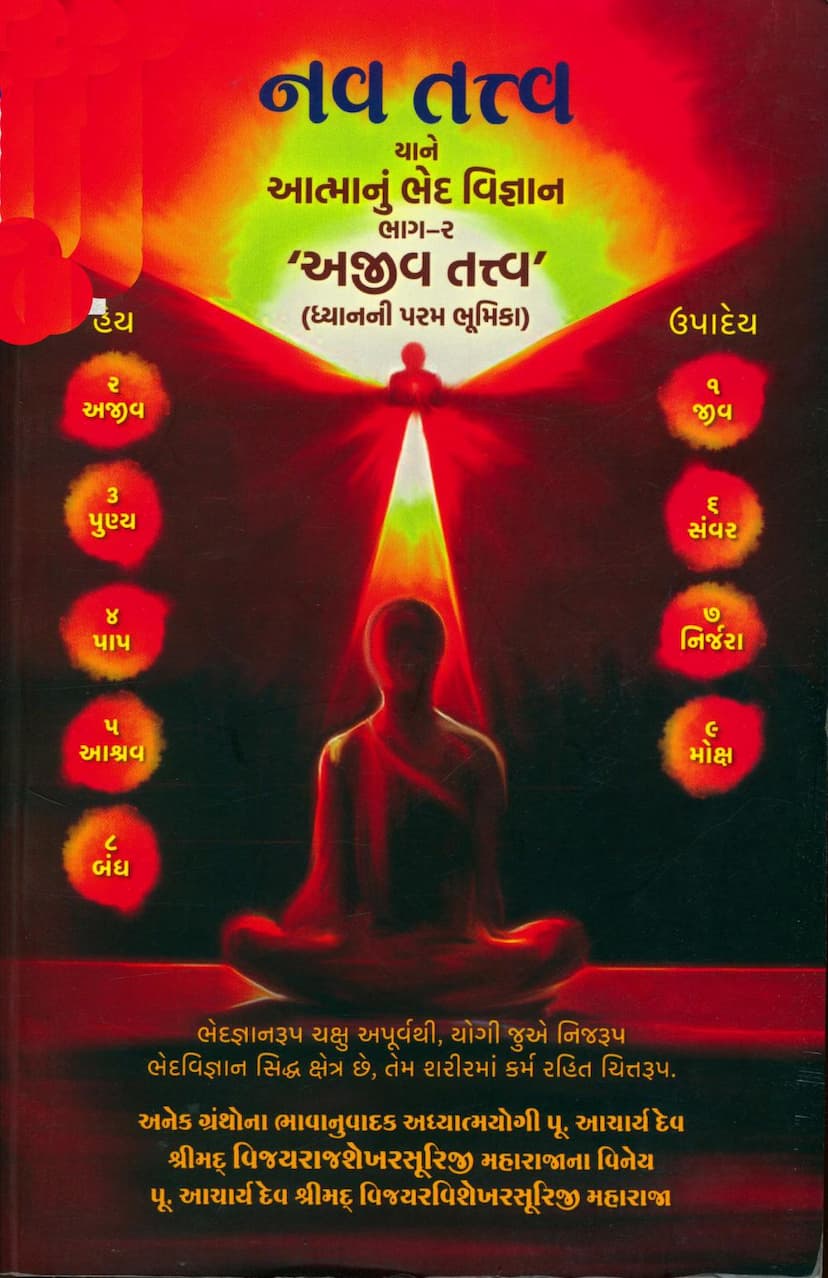Navtattva Part 02
Added to library: September 2, 2025

Summary
The book "Navtattva Part 02" by Vijayravishekharsuri, published by Prabhaben Mangaljibhai Shah Mahuwawala, delves into the concept of "Ajiva Tattva" (non-living entities) within the framework of Jain philosophy, specifically as it relates to achieving "Bhed Vigyan" (discriminative knowledge) and the path to spiritual liberation through "Dhyana" (meditation).
Key Themes and Concepts:
- Bhed Vigyan (Discriminative Knowledge): The central theme is understanding the fundamental difference between the soul (Jiva) and non-living entities (Ajiva). This knowledge is considered essential for spiritual progress and liberation.
- Ajiva Tattva: The book systematically explores the categories of Ajiva, which are the six fundamental substances in Jainism:
- Dharmastikaya (Principle of Motion): Explains its role in facilitating movement for living and non-living entities.
- Adharmastikaya (Principle of Rest): Describes its function in enabling entities to rest or remain stationary.
- Akashastikaya (Space Principle): Details how space provides a medium for all substances to exist and move.
- Pudgalastikaya (Matter Principle): Explores the various forms, qualities (color, smell, taste, touch), and transformations of matter, which are responsible for the physical world and the bondage of the soul. This section is extensive, covering 10 "parinamas" (transformations) of Pudgala, including subtle and gross forms, and its impact on the soul.
- Kala (Time Principle): Discusses the nature of time and its role in the changes and transformations of substances.
- Dharma and Adharma: Briefly touched upon as principles that assist in motion and rest, respectively.
- Path to Liberation (Moksha): The text emphasizes that liberation (Moksha) is achieved through the destruction of karma (Karma Kshaya). This destruction is facilitated by self-knowledge (Atma Gyana), which in turn is attained through meditation (Dhyana).
- The Importance of Knowing Nine Tattvas (Navtattva): The book reiterates the Jain principle that understanding the nine tattvas is crucial for realizing the soul. It stresses that without understanding the non-living (Ajiva) components, a true understanding of the soul (Jiva) is incomplete.
- Meditation (Dhyana) as the Supreme Goal: The text highlights that the ultimate aim is to reach the highest state of meditation, which leads to self-realization and liberation.
- Distinguishing Self from Non-Self: The book emphasizes the need to differentiate the soul from the body and other material possessions. It explains that the soul is eternal, formless, and pure, while the body and its associated qualities are material and transient.
- Karma and its Effects: The book implicitly discusses how the soul's interaction with matter (Pudgala) leads to karma bondage, which obscures the soul's true nature and causes suffering. Understanding the principles of Ajiva helps in understanding how karma binds the soul.
- Practicing Jain Principles: The text encourages practical application of Jain principles, such as right faith (Samyak Darshan), right knowledge (Samyak Gyana), and right conduct (Samyak Charitra), as the path to spiritual liberation.
- The Role of Gurus and Scriptures: The importance of guidance from enlightened gurus and the study of scriptures like the Navtattva is highlighted as pathways to acquiring the necessary knowledge.
Structure and Content:
The book is structured to systematically explain each aspect of Ajiva Tattva, often using analogies and explanations to make complex philosophical concepts accessible. It delves into the characteristics and interactions of these non-living principles, underscoring their relationship with the soul's journey towards purity and liberation. The detailed explanations of Pudgala's transformations and the 10 "parinamas" illustrate the pervasive nature of matter and how it influences the soul.
Overall Message:
"Navtattva Part 02" serves as a guide for spiritual seekers within the Jain tradition. It aims to provide a clear understanding of the non-living aspects of reality, thereby enabling the reader to better distinguish the eternal soul from the transient material world. This discriminative knowledge is presented as the foundation for meditation and ultimately, for achieving Moksha, the ultimate goal of liberation from the cycle of birth and death. The book encourages introspection and the diligent practice of Jain principles to attain spiritual freedom.